The BEST Smoked Salmon Recipe
Updated Aug 15, 2025
This post may contain affiliate links. Please read our disclosure policy.
Our smoked salmon brine is one of the secrets for making the best smoked salmon on your Trager pellet grill or other kind of smoker. It is by far my favorite food to make on a smoker. This easy smoked salmon recipe uses just a handful of ingredients and can be tailored to your taste.
As a bonus, this tasty salmon stores well because of the smoked salmon brine recipe that we use. You can enjoy offset or Traeger smoked salmon for days after making it.

🍣 Smoked Salmon Recipe Recap
- Brine: 1 quart (1,000 ml) cold water + 90 g Morton kosher salt (about 6 level Tbsp) + 110 g packed dark brown sugar (½ cup).
- Brine time: 3–8 hours by thickness (most fillets: 5 hours).
- Dry: Air-dry 2–3 hours until tacky (pellicle).
- Smoke: Start 140–150°F for a couple of hours, then ramp to 180°F. Brush pure maple syrup every 45–60 minutes.
- Finish: Pull at 130–135°F internal and rest 1 hour (or 145°F for USDA guidance).
- Works on Traeger, offset, and electric smokers. Wood: apple, cherry, or alder. Pro Tip: Like our reverse-sear smoked pork chops, you can use a pellet smoker tube to elevate your smoked salmon flavor.
- Storage: 10 days chilled in an airtight container, ~3 weeks vacuum sealed, up to 1 year frozen.
SUMMARIZE & SAVE ON
Table of Contents
- 🍣 Smoked Salmon Recipe Recap
- Best Smoked Salmon Recipe: Why it Works 💯
- What You Need to Make the Best Smoked Salmon
- 🧂 Smoked Salmon Brine (Exact Ratio + Grams)
- What Kind of Salmon is Best for Making Smoked Salmon?
- How to Make The Best Smoked Salmon
- Traeger Smoked Salmon: Low-Temp Setup & Super Smoke
- Substitutions and Variations
- How to Store Smoked Salmon
- The Besst Smoked Salmon Recipe
- More of the Best Smoker Recipes
Best Smoked Salmon Recipe: Why it Works 💯
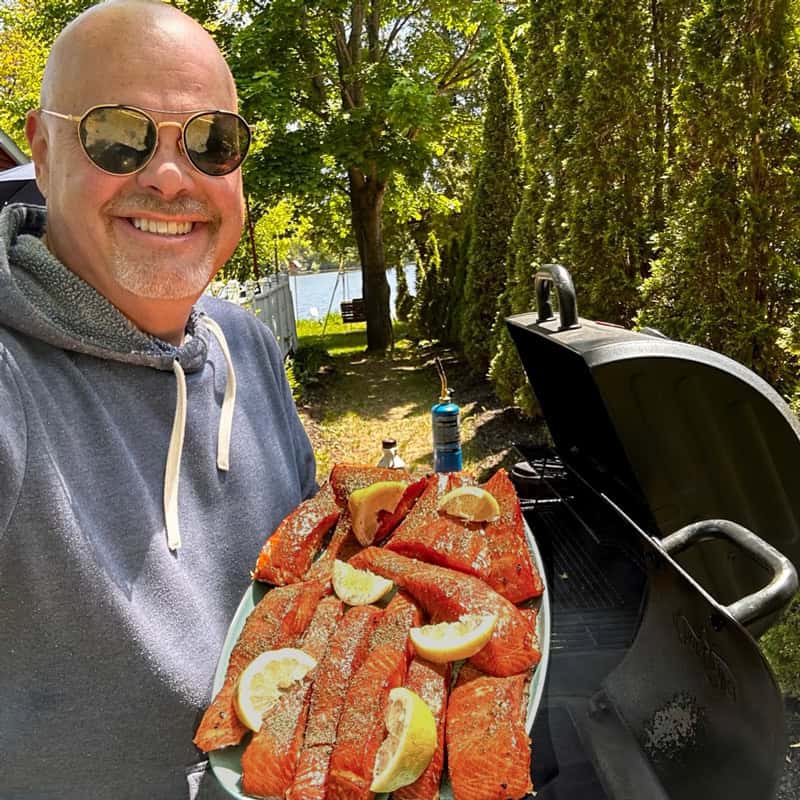
- ✅ Clear, tested method: Precise smoked salmon brine recipe ratio, temps, and timing remove guesswork so your fish stays silky and flavorful every time. 🌡️🧂
- 🧑🍳 Pro technique made practical: Drying builds a pellicle for better smoke adhesion, and a hot water pan helps protect texture during the long cook. 💨
- 🔩 Pellet- and Traeger-ready: Steps are written for any smoker, including Traeger smoked salmon, offset, electric, or ceramic cookers, like a Big Green Egg. 🔥
- 🍁 Balanced flavor: A simple salt-and-brown-sugar brine with optional herbs and a light maple glaze gives sweet-savory depth without overpowering the fish. 🌿
- 📦 Make-ahead friendly: Hot-smoked salmon stores well and tastes great warm or chilled for boards, salads, dips, or brunch. 🧀🥖
- Smoked salmon will keep well, so you can enjoy it for days to come.
I’m a huge fan of delicious salmon recipes. From this Grilled Salmon with Sriracha, or Grilled Ginger and Fennel Sockeye Salmon, to healthy salmon in the air fryer; I love them all. But I have to say, this smoked salmon is my all-time favorite way to make salmon.
The best smoked salmon starts with a simple cold water smoked salmon brine of salt and brown sugar. Next, it is dried from the brine and then smoked over indirect heat. All together this process takes between 12 and 15 hours to finish.
Like other smoked foods, for the best smoked salmon recipe, you want to use a low temperature. The low heat along with your choice of flavored wood will give your fish a heavenly smoky flavor.
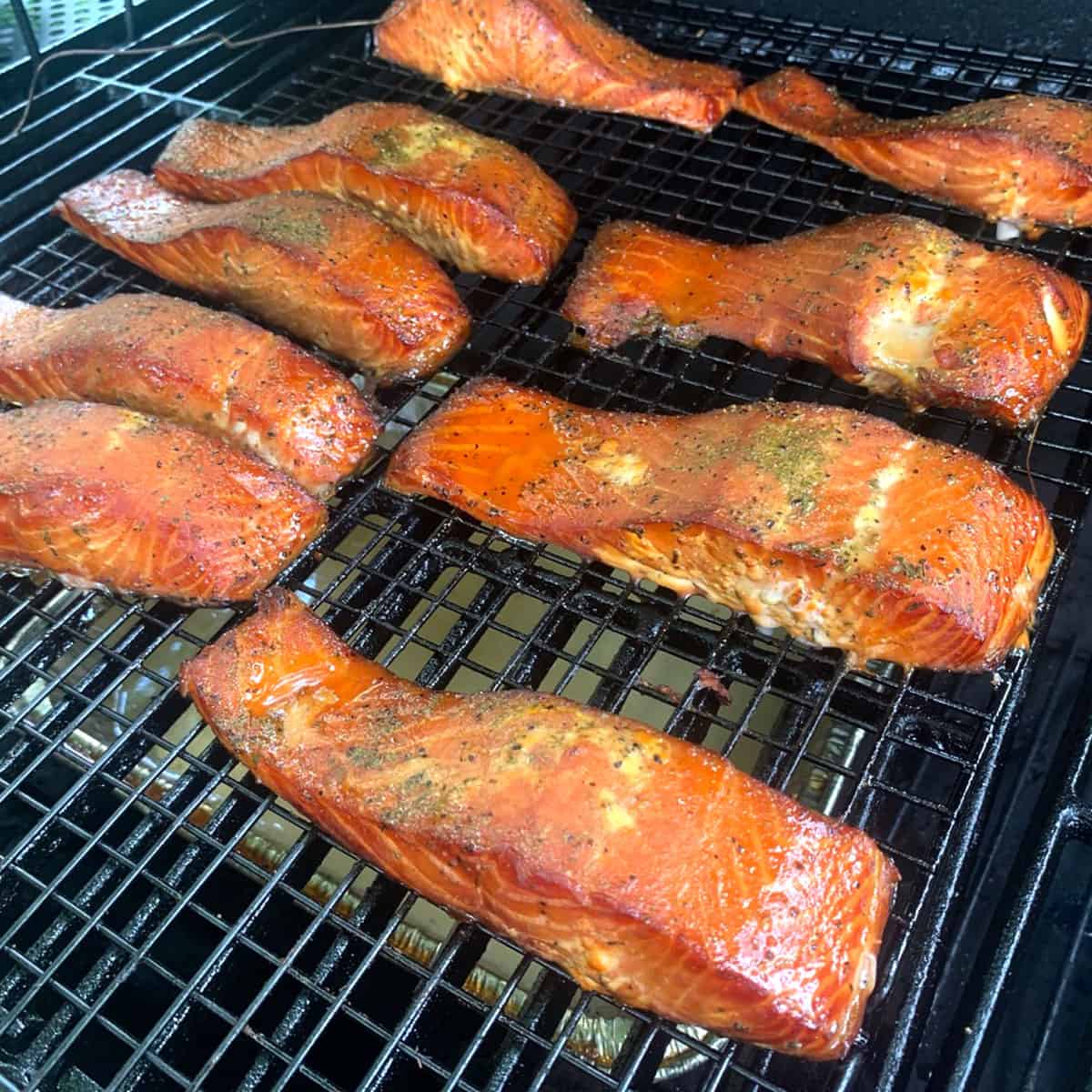
What You Need to Make the Best Smoked Salmon
A Smoker – You can make this smoked salmon recipe on any type of smoker. I use a simple, no-frills old-fashioned offset smoker that uses wood. But you can use an electric smoker like the one we picked up at Aldi for $119.
I love making smoked salmon on a Traeger. It’s not quite “set it and forget it,” but it’s much less labor-intensive than making smoked salmon on a stick smoker.
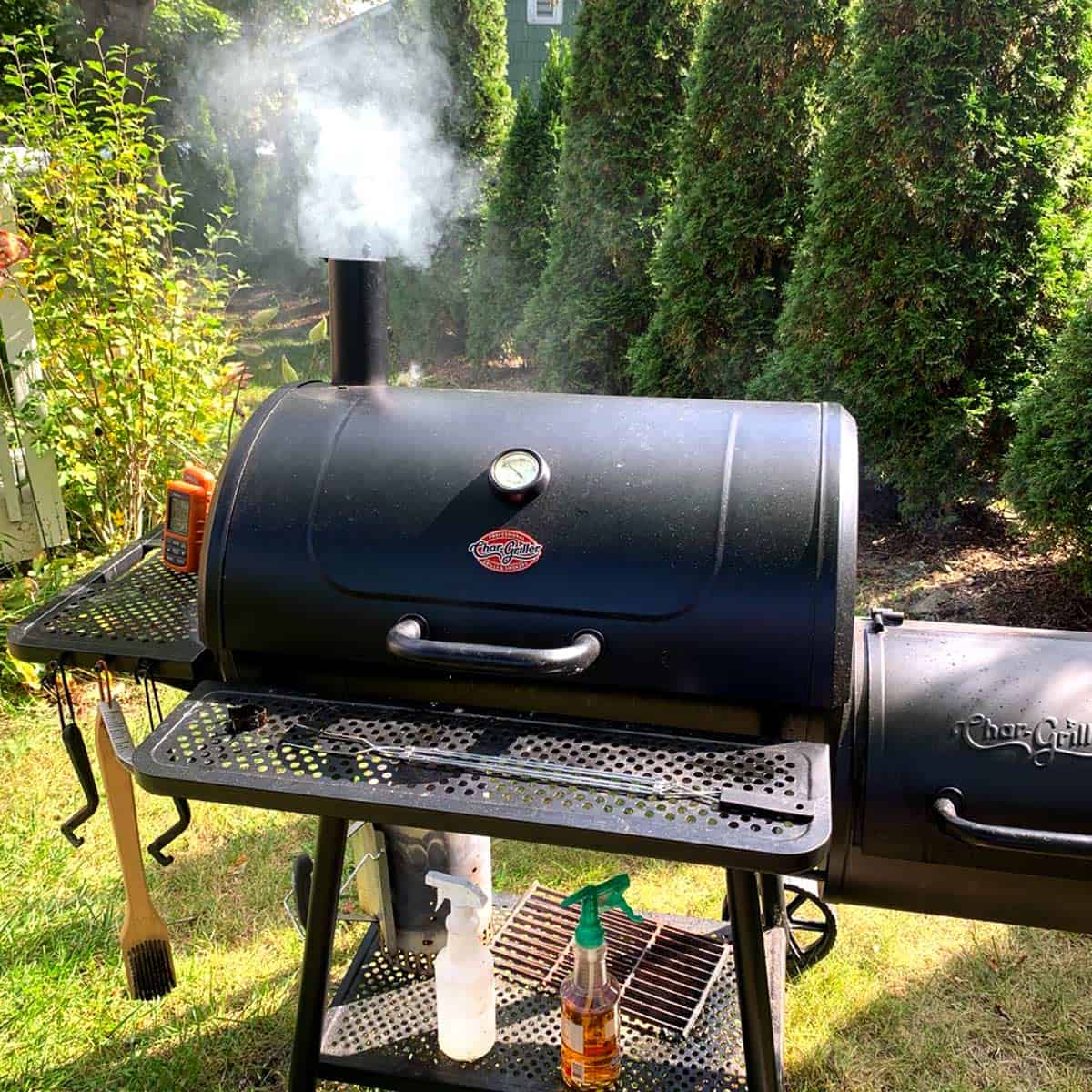
I recommend starting out with a less expensive type. Learn the basics and decide if you like smoke flavored meat and fish. If the answer is yes, consider moving on to the big boys.
Hardwood chips or blocks of wood – This is a matter of preference. I usually prefer apple wood because I also use it when making easy smoked pork tenderloin. But cherry, alder, and oak work well too.
Pro Tip: Light your smoker using a charcoal chimney and hardwood lump charcoal. This will help you avoid the chemicals found in liquid charcoal and produce a cleaner smoker which will not affect the flavor of the salmon. You’ll also want to use these when making your favorite grill recipes on your charcoal or gas grill.
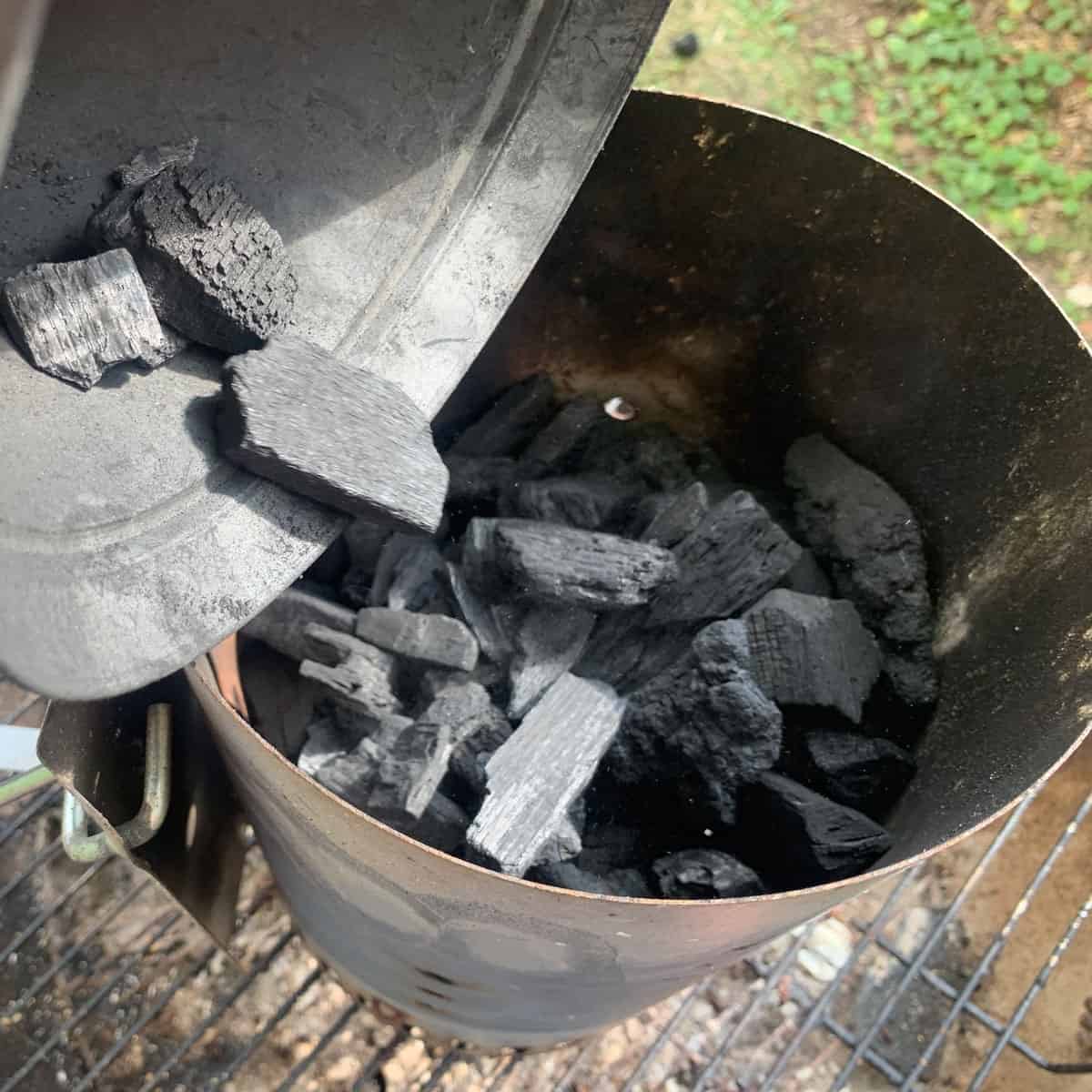
- Large plastic or glass container – You need something that is non-reactive for holding the fish and the brine.
- A cooling rack for drying and cooling.
- Paper towel – For patting the salmon dry when it comes out of the brine.
- Small fan (optional) – For helping to dry the fish when it comes out of the brine.
- Water pan – This goes under the fish (beneath the grate to help keep it from drying out. Pro Tip – Fill this with hot water!
- Pastry brush – Use this to baste the fish with maple syrup while it is on the smoker.
- Thermometers(s) – I use this duo probe grill thermometer when using my grill or smoker. I suggest using this instant-read thermometer to spot-check the internal temperature. It is accurate to 1/2 of a degree and super fast.
🧂 Smoked Salmon Brine (Exact Ratio + Grams)
Per 1 quart (1,000 ml) cold water:
- 90 g Morton kosher salt (about 6 level tablespoons)
- 110 g packed dark brown sugar (½ cup)
Brine Time by Thickness
- ¾-inch pieces: 3–4 hours
- 1-inch pieces: 5 hours
- 1¼–1½-inch center cuts: 6 hours
I dont’ recommend brining smoked salmon over 6 hours as I’ve learned that a prolinged brining time gives the smoked salmon soft and almost mushy texture.
After brining: give the surface a quick rinse (optional), pat very dry, then air-dry on a rack 2–3 hours until the surface feels tacky. This tacky layer (the pellicle) helps smoke stick and protects texture.
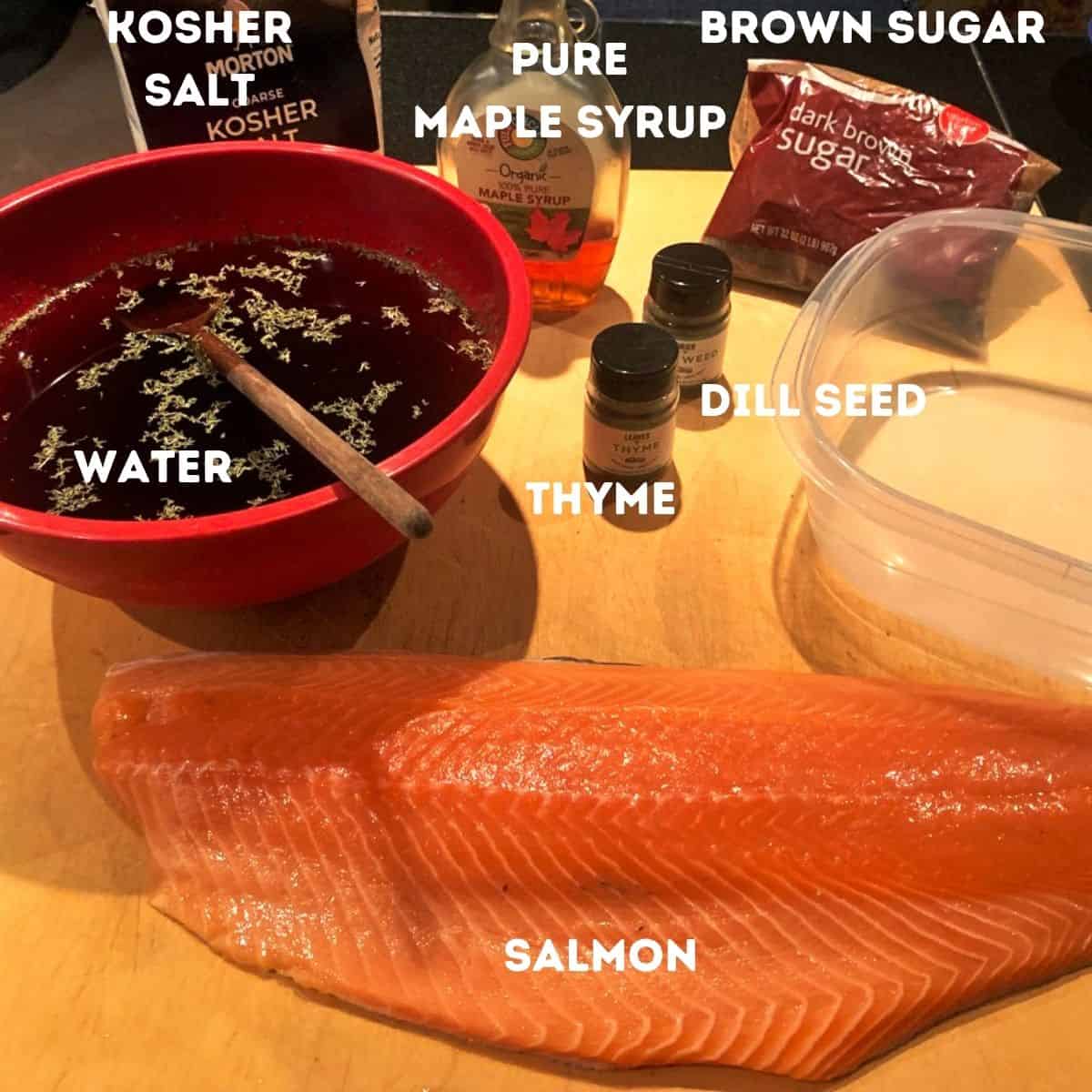
Kosher salt – The larger crystals are what you want to make the brine. You can also use sea salt for this. Avoid regular table salt as the iodine in it will give a bad taste.
Salt Brand Note (Tested)
I’ve tested this brine with both Diamond Crystal and Morton kosher salts and I prefer Morton.
By volume, Morton is significantly denser (about 14 g per tablespoon or ~5 g per teaspoon) while Diamond Crystal is much lighter (about 9 g per tablespoon or ~3 g per teaspoon). That density difference means a spoonful of Morton delivers more consistent salinity for readers who measure by volume, and it aligns cleanly with the gram weights I provide.
Volume-for-volume swaps can change saltiness by roughly 50–60% (e.g., ¼ tsp Morton ≈ 480 mg sodium vs ~280 mg for Diamond), so for absolute consistency use the gram weights listed; if you use Diamond, measure by grams or increase the volume accordingly.
Maple Syrup – Be sure to use pure maple syrup!
Dark Brown Sugar – I prefer the darker and richer flavor you’ll get with this type. If all you have is light brown sugar, that will work too!
Dry Herbs – I use about a teaspoon each of dry dill weed and thyme to add to the wet brine.
- This smoked salmon brine recipe keeps it simple and reliable: 1 quart cold water, ½ cup kosher salt, and ½ cup dark brown sugar, with optional dill and thyme for a clean herbal note.
- You’ll submerge skin-on salmon portions for 5 hours in the fridge, then pat dry and air-dry to build a tacky pellicle so smoke adheres evenly and the fish stays silky. The salt gently firms the flesh, the sugar balances salinity and supports light browning, and the cold-water base protects texture.
- This foundation works across smokers and really shines for Traeger smoked salmon, making your smoked salmon brine both beginner-friendly and competition-worthy.
What Kind of Salmon is Best for Making Smoked Salmon?
If you’re lucky enough to have fresh fish, nothing works better! Wild salmon is always preferred over the farmed type. The Pacific Northwest is usually where the wild kind comes from. Some of these varieties include:
- King salmon (Chinook) has a high-fat content and is often considered to be the best type by many.
- Coho salmon – Has a similar flavor to the above but a more delicate texture.
- Sockeye salmon – Features a deep rich flavor and red flesh.
- Atlantic Salmon – This is always farm-raised but if it’s all you can get, it works just fine for this smoked salmon recipe.
Copper River Salmon is a common type but in reality, this is usually the King, Coho, or Sockeye variety.
As a note, Chum salmon is a smaller variety and is usually canned and sold frozen to overseas markets.
Where to Get Good Salmon
If you want to take the guesswork out of where to buy the best salmon, I always suggest ordering it from Snake River Farms. They always have very high-quality meat and seafood, and the best part is that they’ll deliver it right to your door. It doesn’t get any better than that!
How to Make The Best Smoked Salmon
(Full directions are in the recipe card below.)
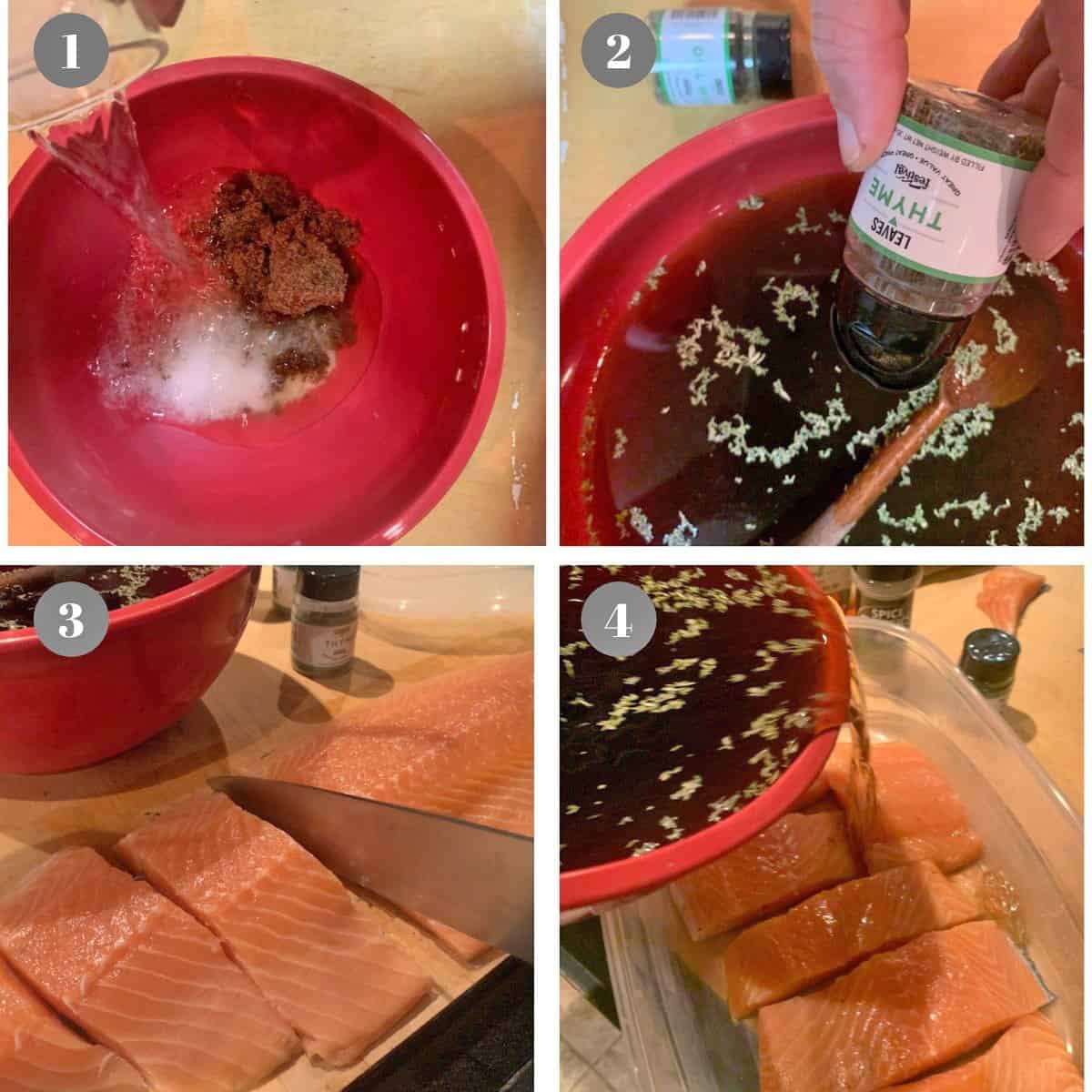
Make the Smoked Salmon Brine
- Add the salt, brown sugar, and cold water to a large bowl. Use a table fork to stir thoroughly making sure everything is completely dissolved.
- Add dill weed and thyme and stir them into the brine.
- Place the salmon fillet on a cutting board. Use a sharp knife and carefully cut it into slices, 2 to 3-inches in width.
- Place the cut pieces into a large plastic or glass container. Pour the smoked salmon brine over it. Then cover and refrigerate for 5 hours.
How to Dry Salmon
Properly drying this is one of the most critical steps for learning how to smoke salmon. During the drying process, a slightly sticky and shiny substance called the pellicle forms.
This takes a minimum of 2 hours but I always go at least 3 hours. The salt from the brine will protect the fish from any harmful bacteria growth while it sits at room temperature.
Want to Save This Recipe, Friend?
A pellicle is a skin or coating of proteins on the surface of meat, fish or poultry, that allows smoke to better adhere to the surface of the meat during the smoking process. Without the formation of a pellicle, the smoke will not stick to the fish.
To help the pellicle form, you want to dry the salmon on a cooling rack. This will allow for good air circulation. If you can open some windows to create a small cross-breeze that is even better.
I use a small fan as shown below.
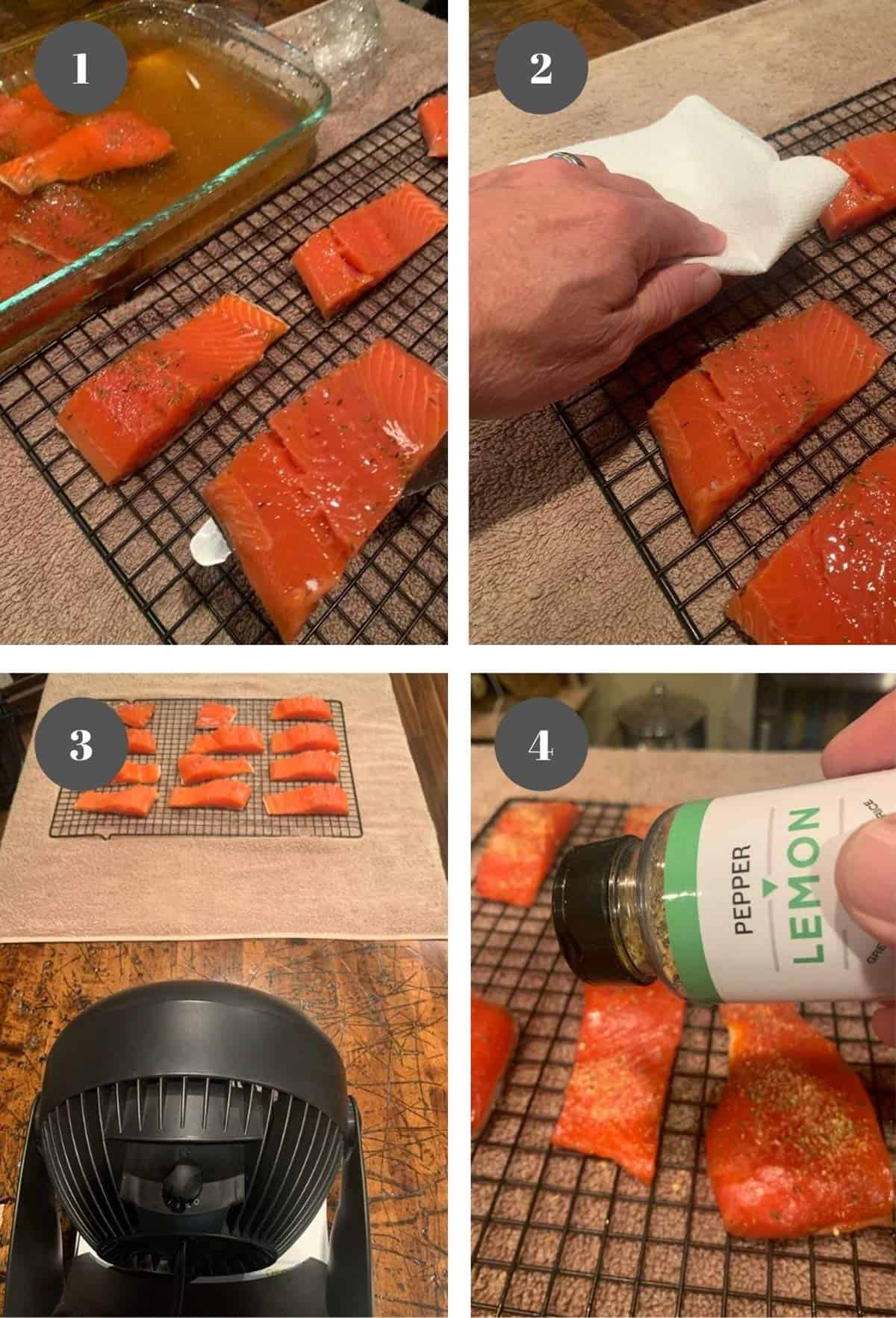
- Place the pieces on a rack, skin side down.
- Gently pat the salmon dry using a paper towel to absorb the extra smoked salmon brine.
- Allow it to dry for at least 2 hours, 3 is better. You can place in front of a fan to help the process.
- After it’s dry, I like to apply a liberal dusting of lemon pepper seasoning.
How to Smoke Salmon
When it is dry and it has a nice pellicle formation for the smoke to stick to, it’s time to get to the fun part.
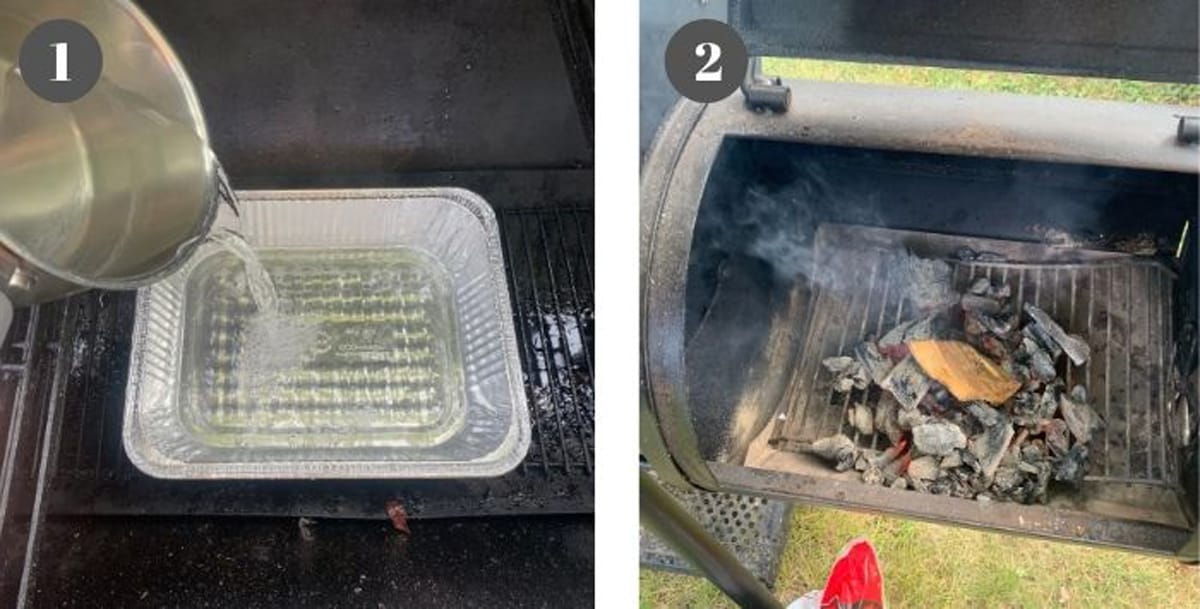
- Place a water pan under the grate of the smoker and fill it with hot water.
- After lighting some charcoal, allow the inside of the smoker to cool to about 140°. Place a handful of wood chips or a single block of wood on the hot coals.
Pro Tip – When you make this smoked salmon recipe, you want to start at a low temperature. You can always add more heat if necessary. Remember this rule: Go slow and low.
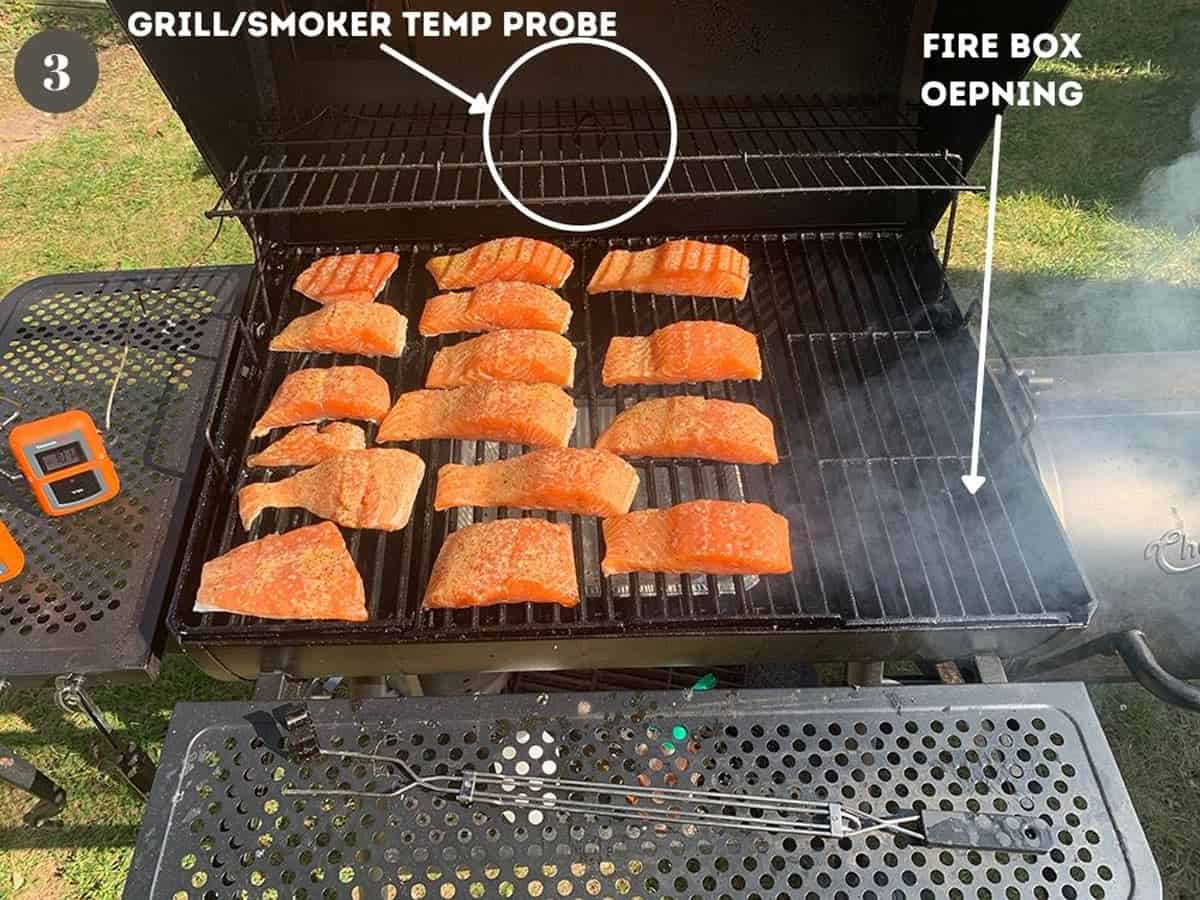
3. Place the salmon, skin side down, on the smoker.
Pro-Tips The area closest to the fire box will be the hottest part of the smoker. Position each portion as far away as possible (all the way to the left.) Make sure the thickest part of each piece is facing the fire box opening.
Use a temperature probe to monitor the smoker temperature. The thermometers that are attached to smokers and grills are notoriously inaccurate.
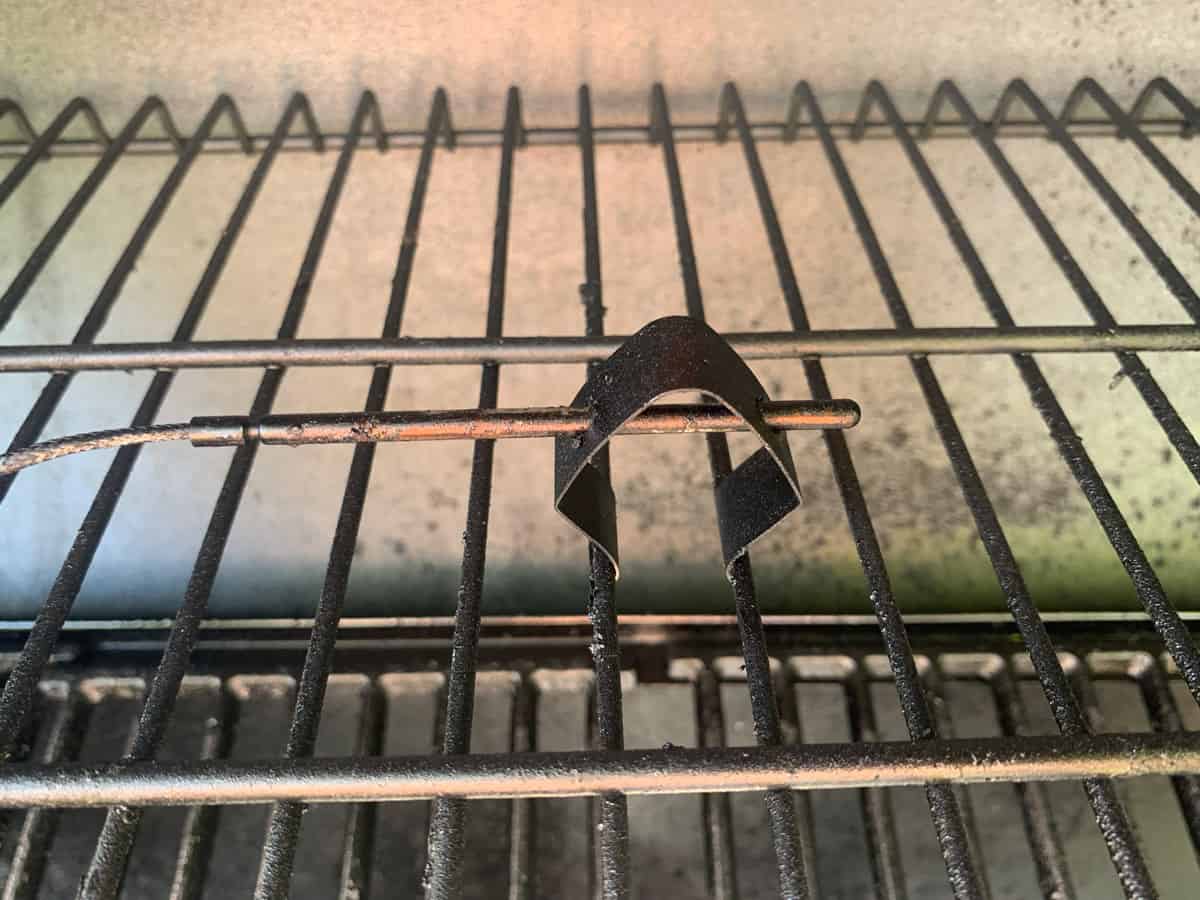
Pro Tip
Through trial and error, I have found the best place to position the smoker temperature probe is above the upper grate rack. You want it to be roughly in the center and above the fish or meat that is being smoked or grilled.
Start the smoker temperature out at 140° to 150° F. Maintain this temperature for a couple of hours and gradually increase the smoker temp to 180°.
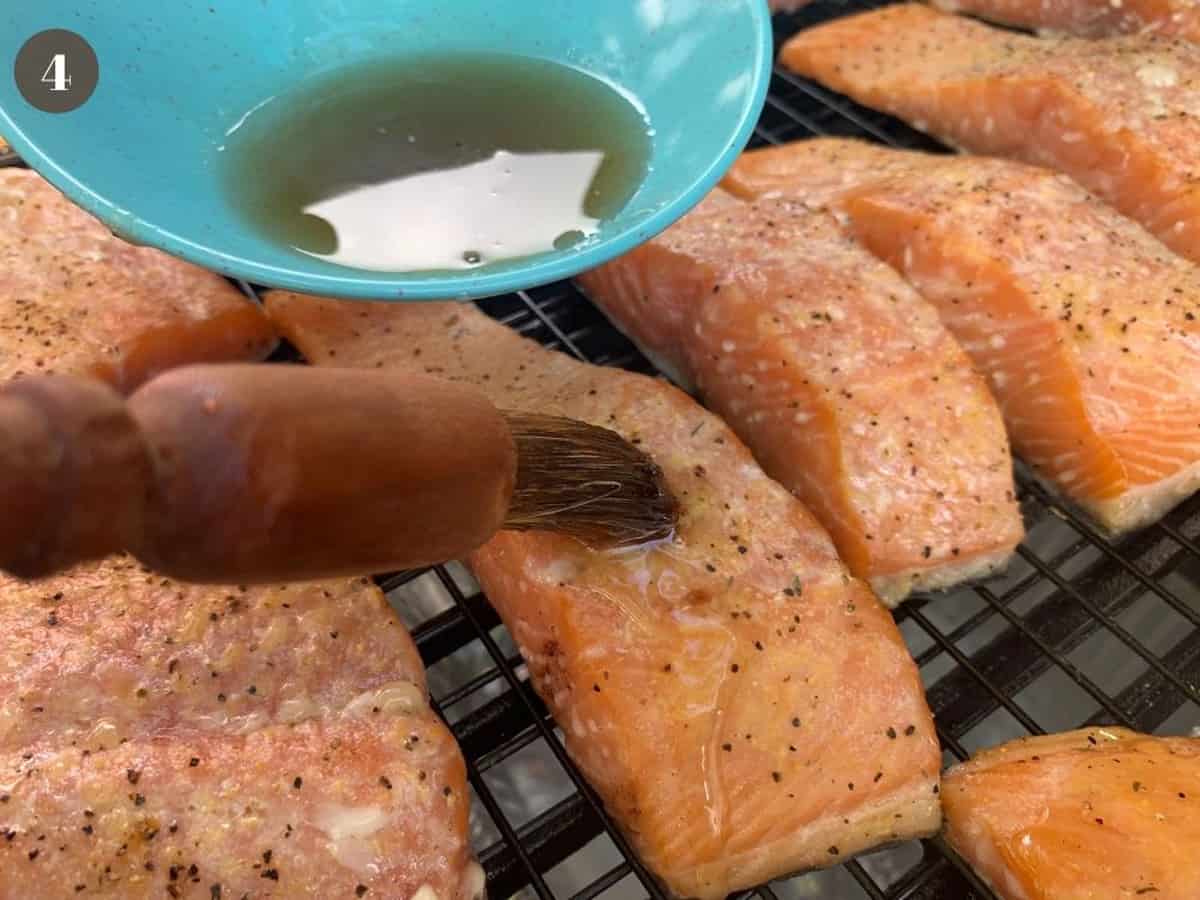
4. While it is slowly smoking, you want to baste the surface of the fish with a layer of pure maple syrup, every 45 to 60 minutes.
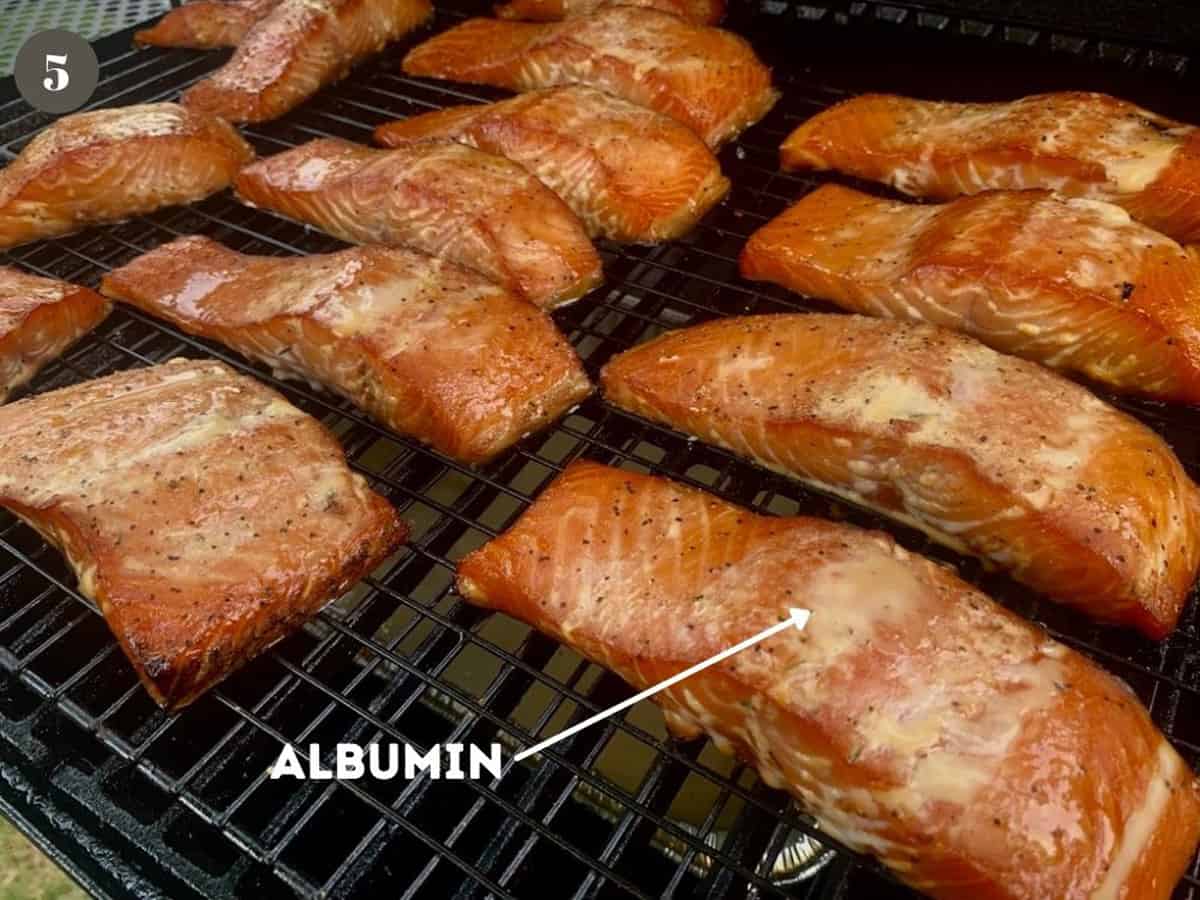
5. As the internal temperature of the salmon continues to rise, you may see the formation of white stuff called albumin come to the surface. This is a harmless protein and can be easily wiped off before eating. All of the albumin seen here was reabsorbed.
When this reaches an internal temperature of 130° F., remove it from the smoker and let is sit at least an hour before eating.
Pro Tip: Do not let the internal temp get above 140°. The fish will dry out rapidly beyond that temperature.
Traeger Smoked Salmon: Low-Temp Setup & Super Smoke
If I’m making this smoked salmon recipe on a Traeger, I use either my Silverton 810 or my Timberline 850. Both have the supersmoke function which I augment with a smoker tube. (See my post video on how to use a pellet smoker tube.)
- Use Super Smoke at the lowest setting your model allows.
- Stabilize gentle heat: place a shallow pan with ice/water on the grate and a hot water pan beneath the fish to keep humidity up.
- Start 140–150°F for a couple of hours, then ramp to 180°F to finish.
- Position thicker ends toward the warmer side of the cooker and monitor with a probe placed near grate height.
- Brush pure maple syrup every 45–60 minutes; pull at 130–135°F internal and rest 1 hour (or 145°F if following USDA guidance).
USDA/FDA guidance for fish doneness is 145°F. Many cooks pull salmon earlier (120–135°F) for a softer texture. Choose based on your preference and always verify with an instant-read thermometer.
Substitutions and Variations
For this smoked salmon recipe, you can use virtually any type of salmon. You can use other types of fish as well, notably trout.
Instead of maple syrup, you can baste the salmon with honey or birch syrup.
Use the dried herb that you have on hand. Rosemary, oregano, and tarragon all work well.
Take a look at our favorite grilling and smoker accessories. We use these products all the time!
How to Store Smoked Salmon
Depending on how you store it, this will stay good from 10 days to up to 1 year.
- Refrigerated in an airtight container: up to 10 days
- Vacuum-packed and refrigerated: up to 3 weeks
- Sealed and frozen: up to 1 year
Brining seasons the fish, firms its texture, and helps it stay juicy; after curing, you should dry the fillet so a thin tacky layer called a pellicle forms, which helps smoke stick. Dry brines using salt and sugar are standard and letting the surface dry thoroughly before smoking is a key step
Yes. Air-dry the brined fish on a rack 2–3 hours until the surface feels tacky. The pellicle helps smoke adhere evenly and protects texture.
For hot smoking, run the cooker around 180–225°F and use a thermometer; the USDA and FDA say fish is safe at 145°F, while many pros pull salmon earlier, around 120–135°F, for a softer, moist finish. Choose your target based on your risk tolerance and texture preference, but always verify with an instant-read probe.
You can eat this by itself as an appetizer or as a main course, hot or cold. For added flavor, add some chopped fresh dill, some capers, fresh lemon slices, thinly sliced red onion, and cream cheese.
See our delicious recipe round-up for what to serve with smoked salmon.
I like to add the leftovers to some greens for a salmon salad. You can add this to avocado and egg breakfast, make a seafood chowder, or a smoked salmon dip.
Hot-smoked salmon is cooked because it’s exposed to heat and brought to a safe internal temperature, while cold-smoked salmon is cured and smoked below about 86–90°F so it stays raw in texture and needs careful handling. Pick hot smoke for flaky, fully cooked fish and cold smoke for silky slices after a proper cure.
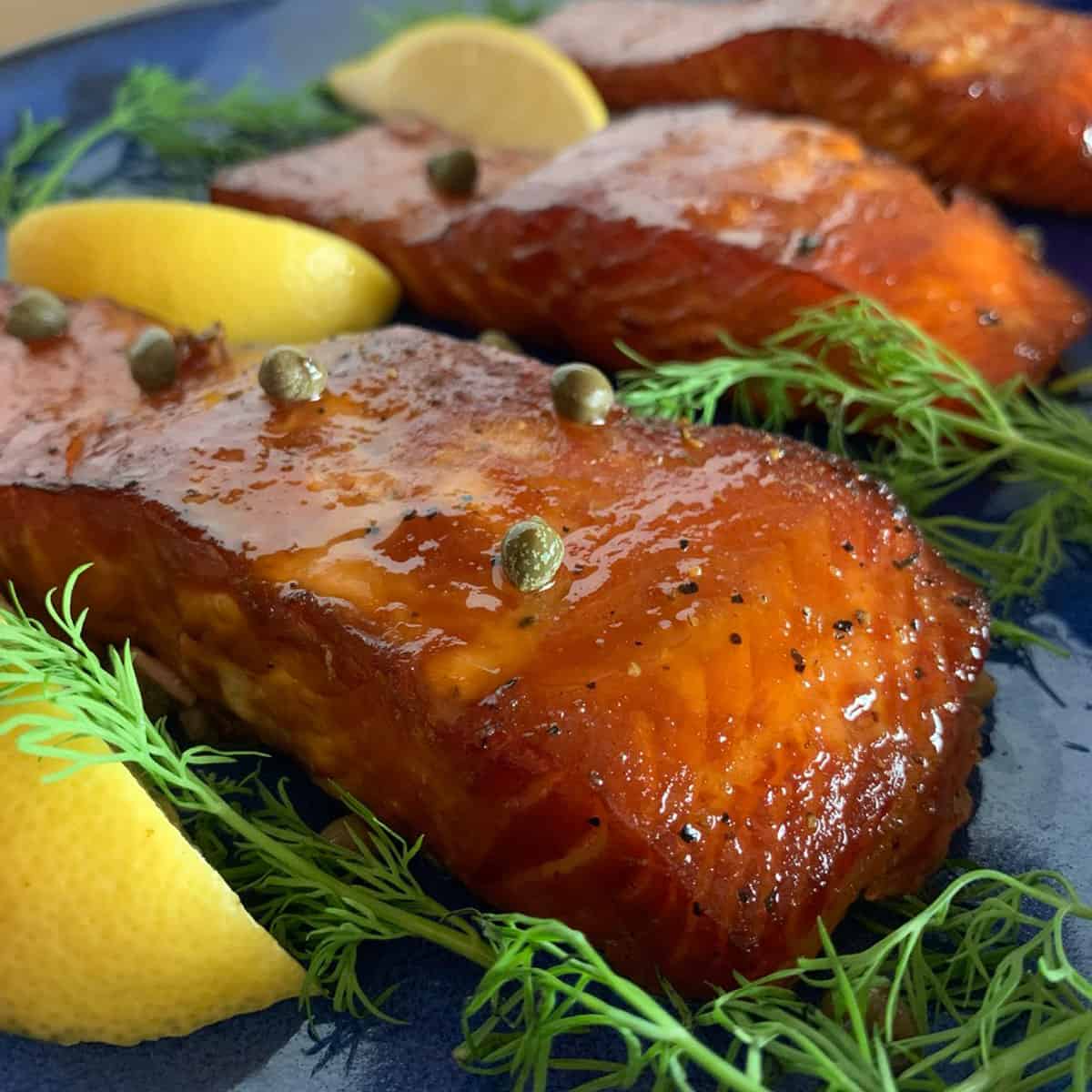
Be sure to try our other high-nutrition and high-protein recipes!
👨🍳 Tried this Recipe? Please leave a ⭐⭐⭐⭐⭐ rating in the recipe card below and leave a comment. We love hearing from our readers!
⏩ Stay in touch with us on social media by following us on Facebook, Pinterest, Instagram, and YouTube!
📬Get our Recipes delivered to your inbox for FREE!
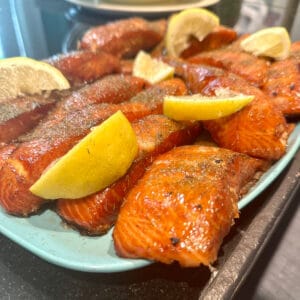
The Besst Smoked Salmon Recipe
Want to Save This Recipe, Friend?
Equipment
Ingredients
- 6 lbs salmon
Smoked Salmon Brine Recipe
- 1 quart cold water, 1,000 ml.
- 1/2 cup kosher salt, 90 grams, or about 6 level tablespoons Morton's brand.
- 1/2 cup dark brown sugar, 110 g.
Optional Seasoning
- 1 tsp dill weed
- 1 tsp thyme
- 1 tsp lemon-pepper
- 1 tsp garlic powder
For the Glaze
- 1/2 cup maple syrup
Instructions
Make the Smoked Salmon Brine and Soak It
- Use a large bowl and mix the water, salt, and brown sugar for the smoked salmon brine. Take a fork and stir it for a few minutes to make sure the solids are dissolved in the water. Add the dill weed and thyme.
- Place the salmon fillets on a large cutting board. Using a sharp knife, carefully slice the fish into 2 to 3-inch portions. Leave the skin on. Place the fish in the brine, cover with plastic wrap and refrigerate for 5 hours.
Dry the Fish
- After it has marinated in the smoked salmon brine, place the fish skin side down on a cooling rack Use a paper towel to gently pat salmon dry. Ideally you should do this where there is a cross-breeze. You can also use a small fan for this purpose. Allow it to dry for a minimum of 2 or 3 hours. This is one of the most important steps! It is critical for a slightly sticky sheen to develop. This is called a pellicle. The pellicle seals the salmon and helps to hold the smoke and it helps keep the salmon from drying out. Once the fish is dry, apply a liberal dusting of lemon-pepper seasoning and a touch of garlic powder.
How to Smoke Salmon
- Place a water pan below the grates of our smoker and fill it with hot water. Then, place salmon on the smoker and start out on low heat at 140-150°. Brush the fish with pure maple syrup every 45 minutes. After a couple of hours, gradually bring the temperature up to 180°. Your target internal temperature is 130-135°.
Notes
- If you smoke too high too fast you’ll get a fair amount of white stuff called albumin. Some is OK and expected. The less you get, the more moist your fish will be.
- Try not to let the pieces get above 140°. They start to dry out pretty fast above that.
- Experiment with the smoked salmon brine recipe and add dry herbs like thyme and garlic. Let your taste buds guide you.
Nutrition
Nutrition information is automatically calculated, so should only be used as an approximation.
More of the Best Smoker Recipes
Grill and Smoker Recipes
Smoked Brisket Flat (The Ultimate Guide)
Cooking Tips and Tricks
How Long Does Smoked Salmon Last? A Complete Guide
Cooking Tips and Tricks
How Many People Does a Brisket Feed?
Grill and Smoker Recipes
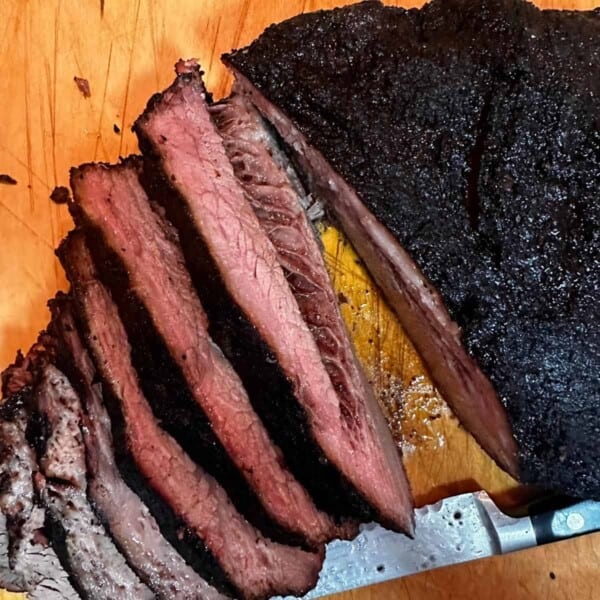

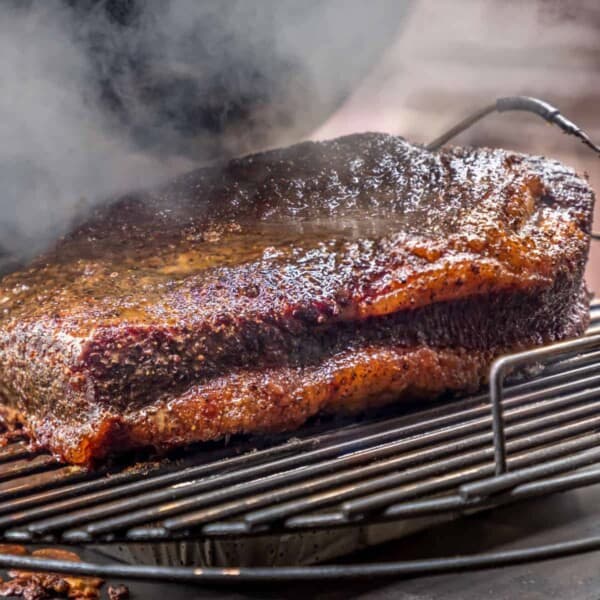
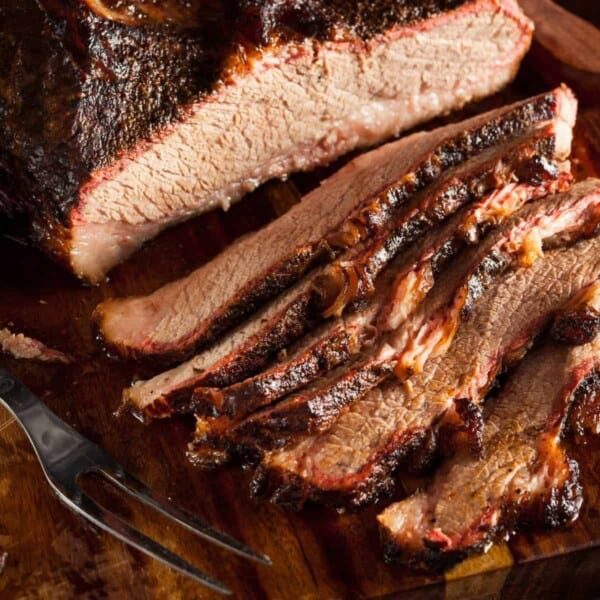
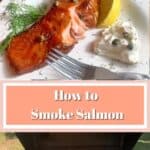











I love smoked salmon and decided to give it a try on my own. This recipe is simple and I have made it several times now. I was with great tasting Smoked salmon in the end. Good job, providing this one!
Can we eliminate the brown sugar. I want no hint of sweetness in my smoked salmon.
Certainly, you may want to omit the Pure maple syrup then as well. If that’s the case, consider basting with a neutral-tasting olive oil (or lemon juice infused with dill weed) to help keep it from drying out.
Thanks for this well explained & straight forward post. Will be looking for a smoker this weekend & using this delicious sounding re pie, using maple syrup.
Just back from Alaska with a cooler full
wild salmon. I’m all set for the smoke fest event now! Thanks for recipes & new ideas for smoking!
I have always been afraid to make salmon. You have inspired me to try this recipe this weekend. Thank you,
This looks absolutely delicious. Your pictures are beautiful. I can almost taste that salmon.
I just got a smoker for my birthday and have been afraid to use it. Thank you for the easy step by step instructions. I am going to try this weekend!
Beautiful post. Wish I were there for the tasting!
Thank! This smoked salmon recipe gets better every time we make it!